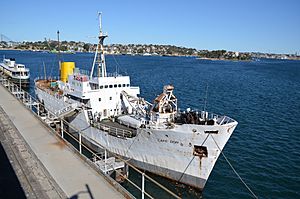MV Cape Don facts for kids

MV Cape Don in 2014
|
|
Quick facts for kids History |
|
|---|---|
| Name | Cape Don |
| Namesake | Cape Don Light |
| Owner | Sea Heritage Foundation Pty Limited |
| Route | Australian coast |
| Builder | NSW State Dockyard, Newcastle, New South Wales |
| Laid down | 1962 |
| Launched | 28th May 1962 |
| Completed | 1963 |
| Maiden voyage | 29th March 1963 |
| In service | 1963 |
| Homeport | Fremantle |
| Identification |
|
| Status | Preserved as a museum ship in Waverton, New South Wales |
| General characteristics | |
| Type | Lighthouse tender |
| Tonnage | 2,103 GRT |
| Length | 74.3 metres (244 ft) |
| Beam | 12.8 metres (42 ft) |
| Draught | 4.37 metres (14.3 ft) |
| Installed power | 2,000 brake horsepower (1,500 kW) |
| Propulsion | Polar M65T engine, 4-blade 2.6-metre (8 ft 6 in) variable-pitch propeller |
| Speed | 12.5 knots (23.2 km/h) |
| Complement | 39 |
The MV Cape Don is a special ship with a long history. She used to be a lighthouse tender, which means she helped supply and maintain lighthouses along the Australian coast. Today, she is a museum ship and a training ship in Waverton, New South Wales, Australia.
Cape Don is the only Australian lighthouse supply ship still around. Because of her importance, she is listed on the Australian Register of Historic Vessels. She was built in 1962 and served the Commonwealth Lighthouse Service from 1963 to 1990. She also took part in many important science trips.
The MV Cape Don Society and the Sea Heritage Foundation are working to restore Cape Don. You can find her docked at the old coal loading wharf in Balls Head Bay, Waverton, New South Wales.
Contents
Building the Cape Don
The Cape Don was built in 1962 at the NSW State Dockyard in Newcastle, New South Wales. She was designed to be a lighthouse tender. This means her main job was to carry supplies, equipment, and people to lighthouses, lightships, and buoys.
Sister Ships
Cape Don was not alone! She had two identical sister ships, the Cape Moreton and the Cape Pillar. All three were designed by the Australian Shipping Board for the Commonwealth Lighthouse Service.
Ship's Features
The Cape Don is quite a large ship. She weighs about 2,140 tonnes. She is about 76.25 meters (250 feet) long and 12.8 meters (42 feet) wide.
She is powered by a special 5-cylinder diesel engine. This engine turns a single propeller with four blades. The propeller can change its pitch, which helps the ship move efficiently through the water. The ship also had 3 lifeboats and a special vehicle called a LARC-V on her side.
Cape Don's Life at Sea
The Cape Don was officially launched on May 28, 1962. She began her service in 1963.
Science Expeditions
Besides her lighthouse duties, Cape Don was also used for scientific research. In 1979, a team of scientists used her to set up a marine monitoring station in the Bass Strait. This was the first time a scientific study of this area was done.
In 1985, Cape Don helped move the tower of the first Neptune Islands lighthouse. She transported it to Port Adelaide so it could become part of the South Australian Maritime Museum collection.
Training for the Future
Since October 2022, TAFE NSW has been working with the Sea Heritage Foundation. They use the Cape Don to teach students about the maritime industry and hospitality. This helps train the next generation of sailors and workers.
Finding Investigator's Anchors
One of the most exciting missions for Cape Don was in 1973. She was used to find and bring up two anchors from HMS Investigator. This old ship belonged to Matthew Flinders, a famous explorer.
The Lost Anchors
Matthew Flinders had to throw these anchors overboard during a storm in 1803. This happened near Middle Island in the Recherche Archipelago, Western Australia.
The Search and Recovery
The search for the anchors began in December 1972. Members of the Underwater Explorers Club of South Australia led the expedition. On January 14, 1973, they found the first anchor, called the best bower anchor. A few days later, they found a smaller anchor, called a stream anchor. Both anchors were brought up on January 19. The best bower anchor went to the South Australian Maritime Museum in Adelaide. The stream anchor went to the National Museum of Australia in Canberra.
See also
- State Dockyard
- HMS Investigator Anchors

